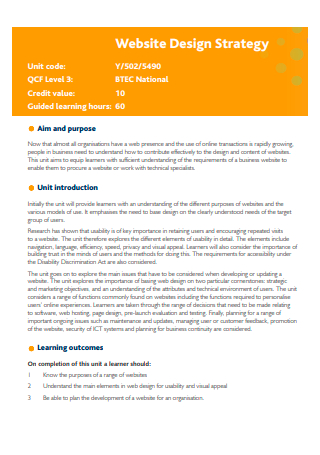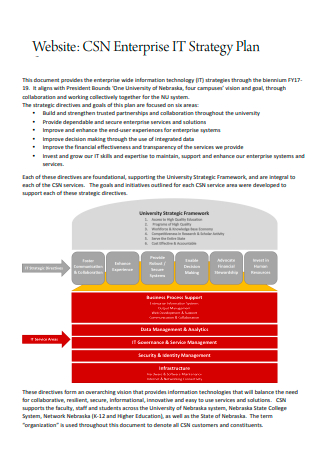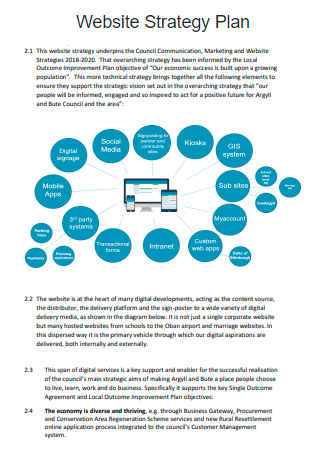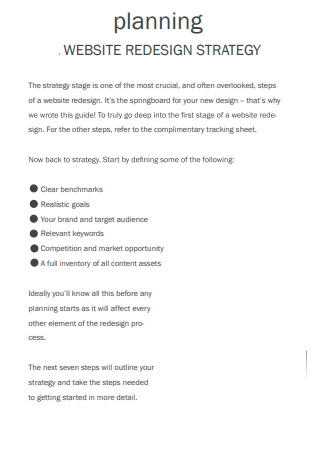3+ Sample Website Strategy Plan
FREE Website Strategy Plan s to Download
3+ Sample Website Strategy Plan
What is a Website Strategy Plan?
Different Types of Website Strategy Plans
Basic Components of a Website Strategy Plan
How to Write a Website Strategy Plan
FAQs
What are the basic components of a website strategy plan?
What are some examples of website strategy plans?
What are the important steps in the website strategic planning process?
How to create an effective website strategy plan?
What is a Website Strategy Plan?
A website strategy plan is a clear, comprehensive, and well-integrated roadmap composed of strategy and design thinking goals, objectives, desired outcomes, and a sequence of steps that significantly guides branding managers, web developers, web designers and business marketing strategists in creating an appealing, functional, and responsive website suited for the company, or organization. This action plan is a beneficial management tool with the purpose of transmitting strategic goals, explaining the web development process, emphasizing the focus of web developers and web designers along with the vision of brand managers and business executives, and highlighting the connection of website strategic planning and budgeting. Web developers, web designers, branding managers, business marketing strategists, and other key strategic planners should work side by side to build up better relationships, collaboration, effectiveness, and longevity while utilizing this plan especially when reaching more development and success.
Another survey report revealed that 38% of consumers who visit a website for the first time look at the layout or navigational links on a webpage. People prefer websites that evoke minimalism and simplicity so that they can easily access and navigate the entire webpage with comfort and satisfaction. That’s why it is very important for business firms and organizations to formulate and put their web design strategies into effect by creating a systematic website strategy plan. Thus, all kinds of working professionals involved in web development, web design, and web content marketing such as project supervisors, web developers, UX developers, web designers, content design strategists, marketing design strategists, business managers, and business owners should effectively create a comprehensive website strategy plan.
Different Types of Website Strategy Plans
The world wide web or simply, a website is like a window to the world through which a person can meet people from anywhere. It also acts like a limitless library consisting of documents and links which are real, virtual or indexes that exist in many formats. Christopher Butler wrote in his book The Strategic Web Designer: How to Confidently Navigate the Web Design Process:t “The web is on a winding road to maturity as it is still assembling an identity enormously under the influence of myriad external factors.” So, you should be aware about the different types of website strategy plans that you will use for your business or organization matters. Here we will explain to you about the different types of website strategy plans below:
1. Global E-Learning Website Development Strategy Plan
Defined as the delivery of instructional content through the utilization of electronic technology, e-learning has become an integral part of the modern education system, being found widespread applications in wide-ranging sectors such as arts, design, IT, healthcare, marine, telecommunications, retail, business, and financial services. A report about the global e-learning industry has shown that ongoing content digitization efforts in the academic sector, and rise in student enrollments for online courses on a part-time and full-time basis are helping support growth in the academic segment. According to Developments in Virtual Learning Environments and the Global Workplace, online learning and education grow from the roots similar to the study of virtual teams, connecting technology to the knowledge creation processes for learning. There are many virtual teams around the world that continue on developing contents and the learning infrastructure for a class with the focus of preparing students for the modern digital and global workplace. Some famous e-learning website platforms are Coursera, edX, Adobe Systems, GetSmarter, Macmillan Learning, Persona Learning, and Skillshare. To further entice prospective students and teachers for your e-learning platform, web developers and web designers should prepare a cohesive web development strategy plan to make interactive and functional e-learning websites that easily guides students in their online studies efficiently and helps teachers in their virtual classroom teaching. Creating a strategic plan for a global e-learning website is an essential method in developing proactive steps to fulfill a goal, and assessing immediate issues and concerns in the e-learning platform.
2. Corporate Rebranding and Website Redesign Strategy Plan
Is your sales pipeline drying up? Is your revenue growth flagging? Perhaps your corporate brand and your website have some issues. Both of these aspects are crucial to the success of your business. Business rebranding is a process of changing the way a business presents itself to the public through every channel like the logo, color palette, typography, photography, icons, company name, value proposition, slogan, content, voice and tone. Rebranding is like refreshing a brand into the next level. The most significant thing to consider in this process is reinventing, and enhancing the elements of a corporate brand within the context of your business goals. Through corporate rebranding, it can elevate the brand equity if it succeeds in attracting and retaining more customers. On the other hand, website redesign is like giving a facelift to your website by transforming the code, content, structure and visuals of the website which will help in driving more traffic, increasing user engagement, improving user experience (UX) and generating more and higher-quality leads for your sales team. Thus, preparing a well-defined corporate rebranding and website redesign strategy plan is useful in making your corporate brand and website user-friendly, functional and fast.
3. Digital Marketing Agency Website Design Strategy Plan
Gayle Fuguitt said: “We want to know what consumers are looking for, what their values are, and how we can meet their needs. It’s not just about Big Data; it’s about translating that into the truth.” Digital marketers aim on reaching customers, building brand awareness and promoting products and services by using digital channels which include content marketing, search engine optimization (SEO), video marketing, mobile marketing, online advertising, email marketing, and social media marketing. A typical digital marketing agency uses omnichannel marketing, multichannel marketing, or single-channel marketing to reach customers online. Writing a digital marketing agency website design strategy plan is an important method to develop an engaging website for the agency.
4. K-Culture Merchandise Shop Website Strategic Plan
From K-pop, K-beauty, K-dramas, K-food to K-toons, South Korean culture or Hallyu wave has now spread worldwide as it continues to attract people across diverse ethnical backgrounds and cultures. If you are currently managing a K-culture merchandise shop, creating a user-friendly e-commerce website for your business will help you to entice and retain customers. A survey report shows that 90% of smartphone users say they’d continue to shop at a particular site if their user experience is good. Making an effective website strategic plan for your K-culture merchandise shop is a worthwhile planning tool to support your effort in boosting the sales of your business.
Basic Components of a Website Strategy Plan
Practicality and creativity are the core elements that web developers, web designers and content marketing strategists should deeply consider and apply in proper measure so that their web development, web design and web content marketing projects are ahead of the game. In this section, you will learn how to construct a well-written and systematic website strategy plan. However, a website strategy plan has different kinds of components. Include the following elements for you to create a professional piece of writing:
How to Write a Website Strategy Plan
In the Art of Immersion, Frank Rose elaborates: “[The web is] the first medium that can act like all media – it can be text, or audio, or video, or all of the above… It is inherently participatory – not just interactive, in the sense that it responds to your commands, but an instigator constantly encouraging you to comment, to contribute, to join in. And it is immersive – meaning you can use it to drill down as deeply as you like about anything you care to.” So, the web signifies our willingness to discover who we are and explore the possibilities of human experience. Follow the steps indicate below on how to write a clear and structured website strategy plan:
Step 1: Identify Your Business Goals and Objectives
What are the measurable goals and objectives of your business firm? Contemplate and reflect the choices of your business about the type of value it will build in the website and how that value will be established exclusively compared to its competitors. Through defining clear goals and objectives, project managers, web developers, web designers and digital content strategists can be knowledgeable on how powerful the company brand is in the customers’ minds while seeking out their competitive advantage, fully defining their strategic position. Identifying your business goals and objectives and defining your strategic position can drive up prices of your products and services.
Step 2: Conduct Research, Collect Information and Create Prototypes
Understand the design problem of your website by conducting efficient research and collecting information necessary for your business development such as business requirements, user requirements, competitor analysis, and contextual research. Collect information through surveys, online tracking, transactional data tracking, online marketing analytics, social media monitoring, collecting subscription and registration data and in-store traffic monitoring. Then, generate ideas and select design solutions while creating prototypes through user task modeling, sketching and wireframes.
Step 3: Develop Website Strategic Methods
How will your web design become effective in achieving the challenges and opportunities of your business or organization? Brainstorm some efficient process-oriented methods along with your web development and design team as you test your design solution. Set meetings where all of your members feel their ideas are listened to and valued and where constructive criticism may be openly voiced. Work hand in hand to think and decide the best web design strategies for your initiative. Check the proposed website’s strategic methods and objectives for accuracy and integrity.
Step 4: Perform a Monthly Progress Monitoring and Evaluation
How well does the web design attain its goals and objectives? Perform a SWOT (strengths, weaknesses, opportunities, and threats) analysis from the website strategic methods and procedures to determine what will be specifically implemented in the website strategy plan. So, conduct a careful monthly progress monitoring and evaluation during the website strategic planning process. Pay attention to every little detail and contemplate on what is working and what is not working.
Step 5: Proofread and Finalize the Overall Website Strategy Plan
Review your entire website strategy plan and make sure that you fully present all the core elements in your plan. If you realize that you overlook some sections that require more fundamental elements, we highly suggest that you edit and revise the document as soon as possible.
FAQs
What are the basic components of a website strategy plan?
The basic components that should be included in a website strategy plan are overview, goals and objectives, desired outcomes, resources, strategies and methods, time frame, and monthly progress monitoring and evaluation.
What are some examples of website strategy plans?
Some examples of website strategy plans are digital marketing agency website design strategy plan, cafe and restaurant website enterprise IT strategy plan, corporate branding and website redesign strategy plan, global e-learning website development strategy plan, healthcare and medical services website redesign strategic plan, arts and crafts business e-commerce website strategic plan, k-culture merchandise shop website strategic plan, architectural and interior design school website strategy plan, and many other website strategy plans.
What are the important steps in the website strategic planning process?
The important steps in the website strategic planning process are identifying goals and objectives to define strategic position, conducting research, collecting information and creating prototypes, developing website strategic methods, performing an evaluation, proofreading and finalizing the overall website strategy plan.
How to create an effective website strategy plan?
In order to create an effective website strategy plan, you should bring together a clear and realistic vision and appropriate execution. Be more precise when you develop your design strategic plan while mapping long-term plans to definite objectives and actionable steps, cultivating innovative thinking and expecting and mitigating possible drawbacks.
Leland Dieno said: “Your website is the center of your digital ecosystem, like a brick and mortar location, the experience matters once a customer enters, just as much as the perception they have of you before they walk through the door.” The focus of developing and designing a website is promoting interaction for the potential customers of a business firm or organization. Thus, it is very important to be skilled in writing a well-coordinated website strategy plan for your business or organization. To assist you in effective strategic planning for the development and design of your website, you can learn and apply the tips aforementioned in this article. Plus, we have included several website strategy plan layout templates to guide you including digital marketing agency website design strategy plan, website enterprise IT strategy plan, corporate branding and website redesign strategy plan and other website strategy plan templates for business development that you can download easily and quickly!




